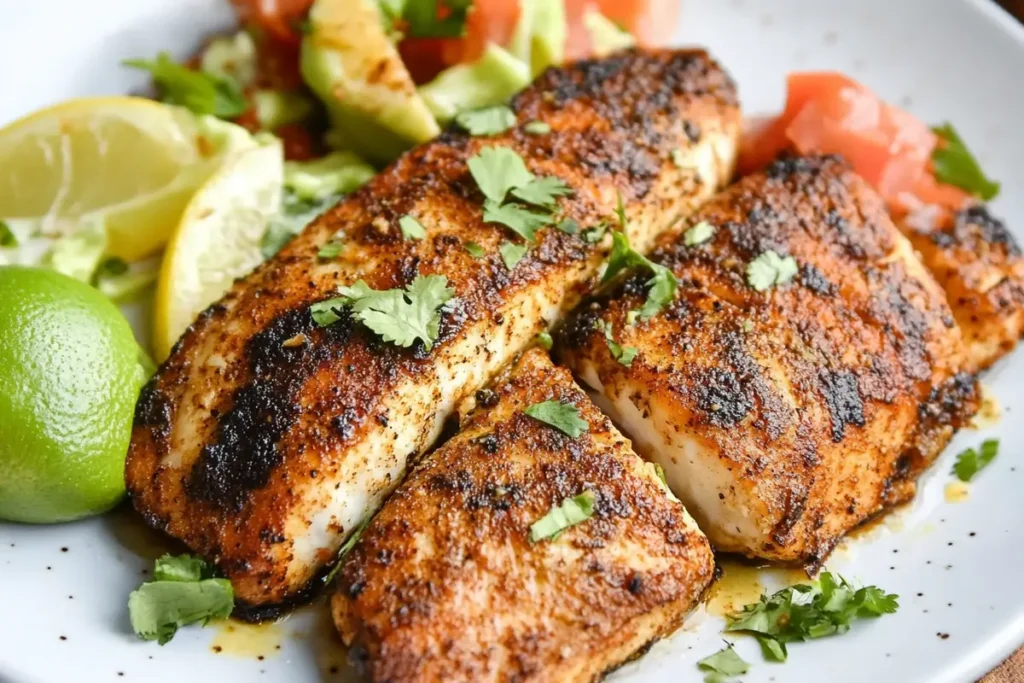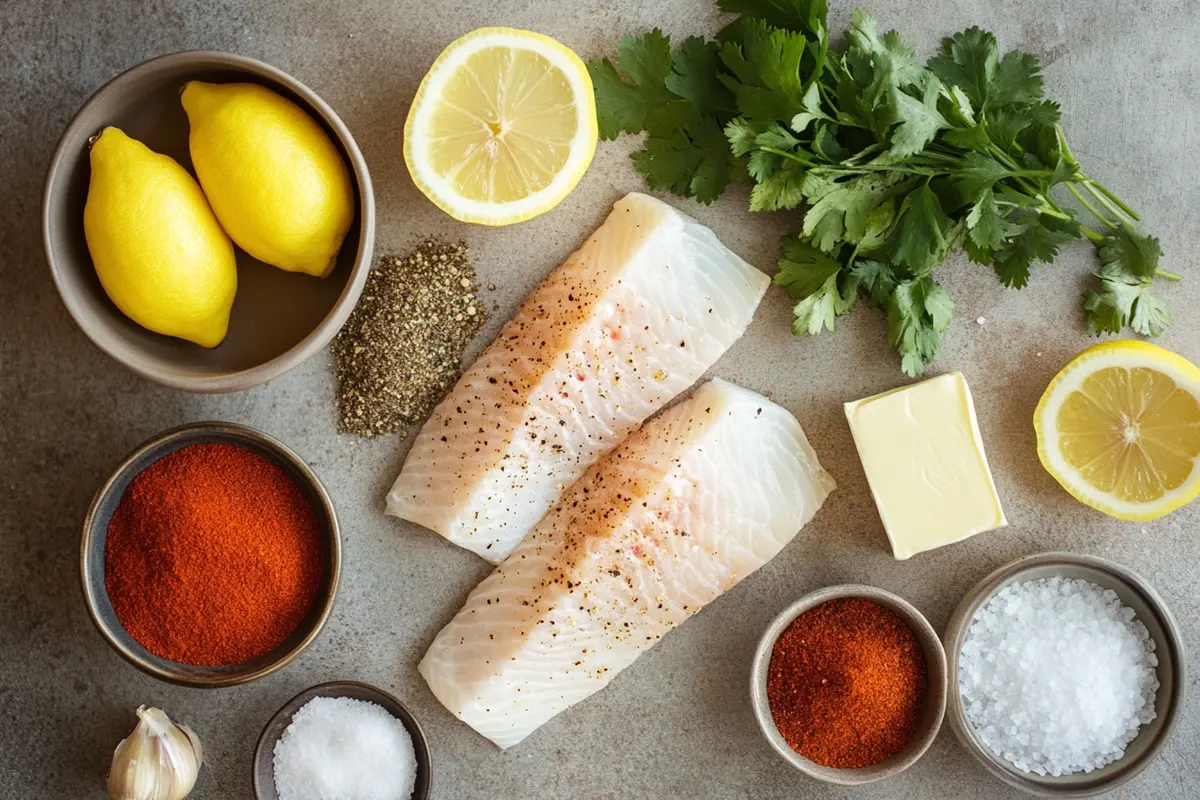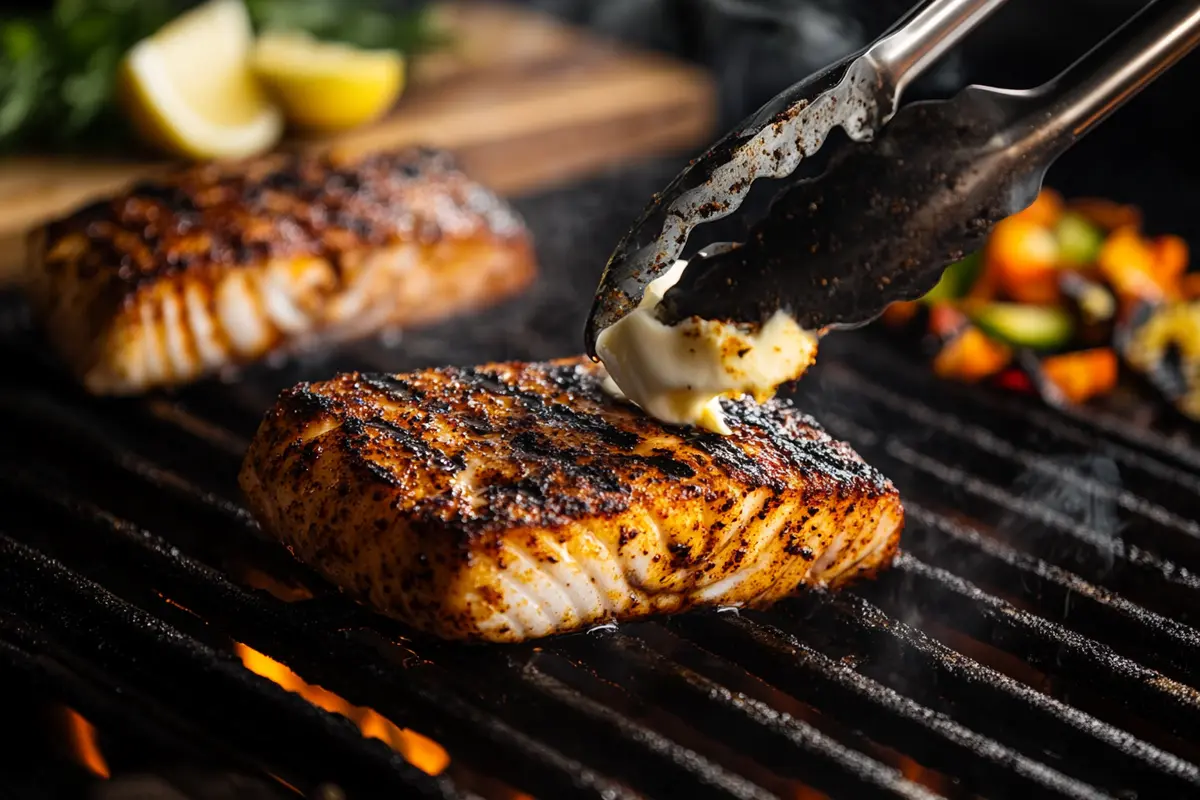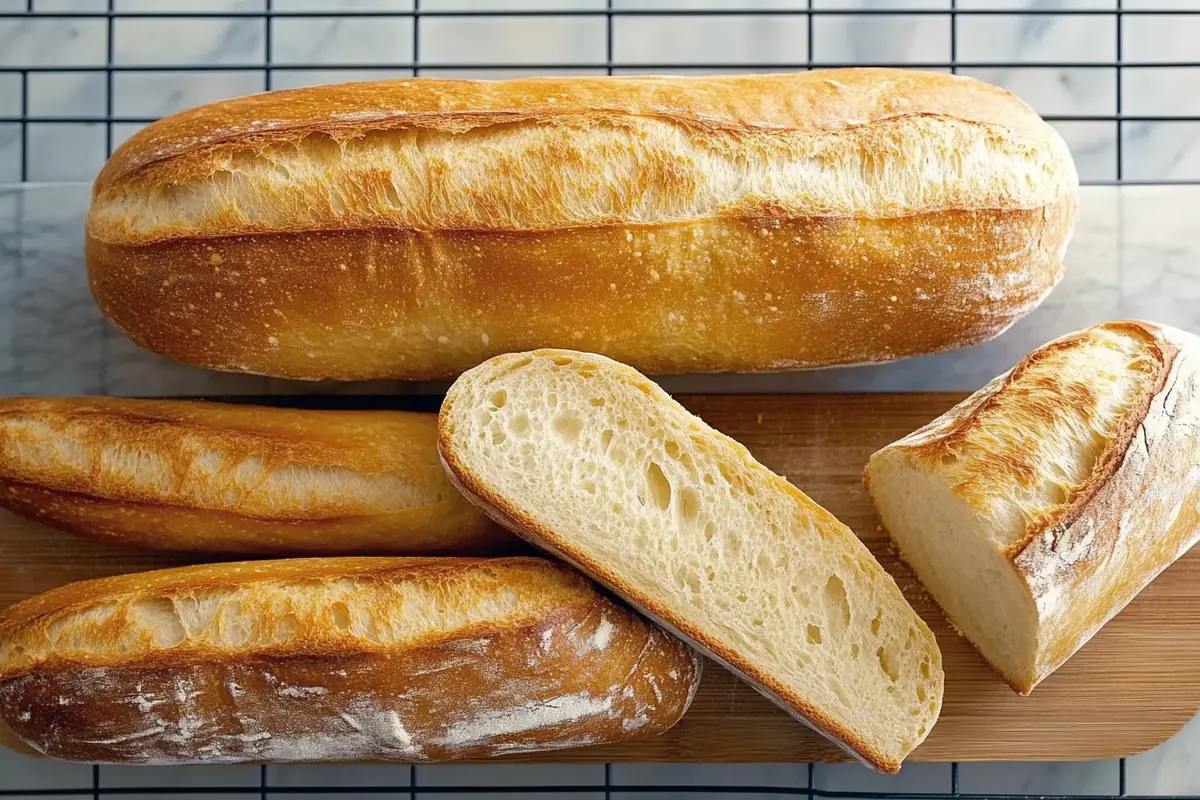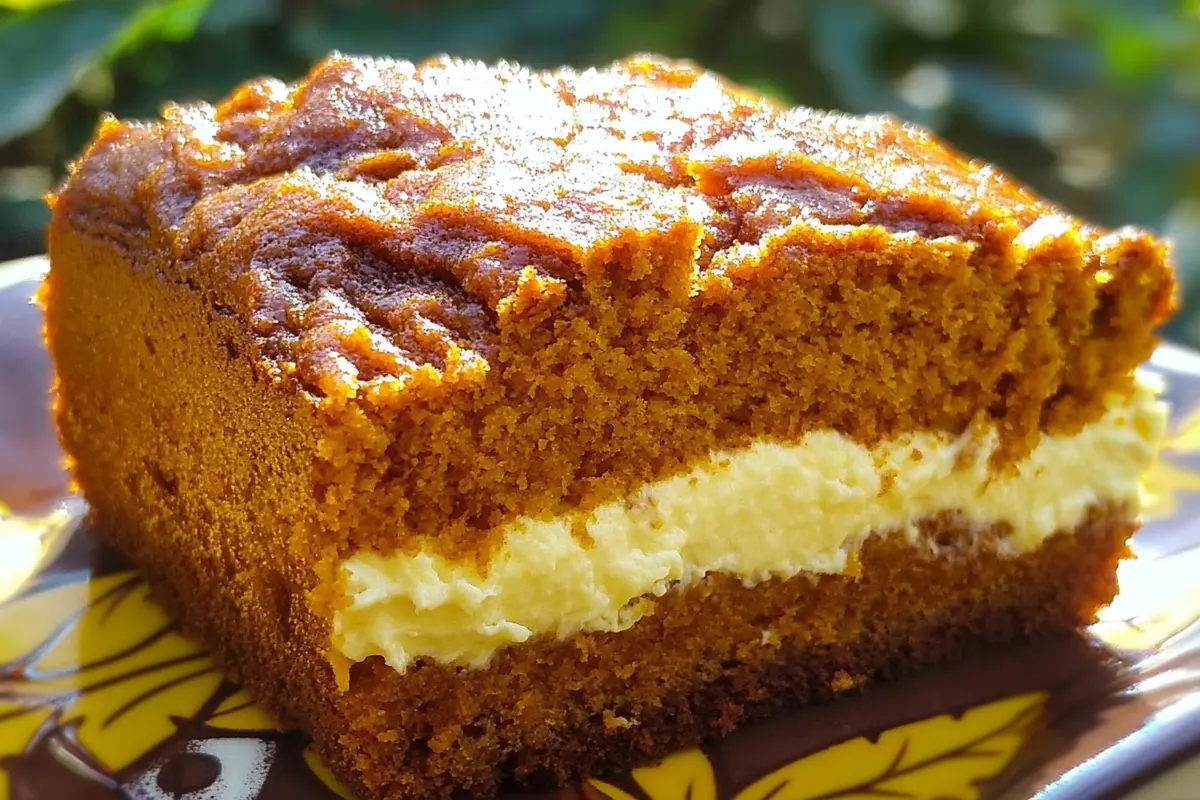If you love bold, smoky flavors and a crispy, seasoned crust, then blackened grouper is a must-try dish! This cooking technique brings out the natural sweetness of the fish while adding a spicy, flavorful kick. Whether you’re a seafood lover or just looking to try something new, this recipe is both easy and incredibly satisfying.
Introduction to Blackened Grouper
What is Blackened Grouper?
Blackened grouper is a delicious seafood dish where grouper fillets are coated in a bold blend of spices and then seared in a hot pan, creating a dark, crispy crust. This cooking method, made famous by Chef Paul Prudhomme, is a staple of Southern cuisine and particularly popular in Cajun and Creole cooking.
The blackened effect happens when the butter and spices form a crust due to intense heat, not because the fish is burnt. This gives it an irresistible smoky, spicy, and slightly charred flavor while keeping the inside moist and tender.
Why Choose Grouper for Blackening?
Firm Texture: Unlike delicate fish that fall apart under high heat, grouper holds its shape beautifully.
Mild Flavor: It has a lightly sweet, neutral taste, allowing the bold blackening spices to shine.
Moist & Juicy: Even when exposed to high temperatures, grouper stays tender and flaky.
Easy to Find: Grouper is widely available at seafood markets and grocery stores, making it accessible for home cooking.
Understanding Grouper
Overview of Grouper Species
The term grouper refers to a large family of fish, known for their firm texture, mild flavor, and thick fillets. Found primarily in warm waters, groupers are a favorite among chefs due to their versatility in various cooking methods, including blackening, grilling, and baking.
Some of the most popular grouper species include:
Black Grouper (Mycteroperca bonaci)
- One of the largest and most flavorful species.
- Found in the Gulf of Mexico and the western Atlantic Ocean.
- Firm, thick fillets that hold up well to high-heat cooking.
Red Grouper (Epinephelus morio)
- Slightly sweeter and more tender than black grouper.
- Commonly caught in the Southeastern U.S. and Caribbean waters.
- Popular in restaurants due to its moist, flaky texture.
Gag Grouper (Mycteroperca microlepis)
- A close relative of black grouper, with a slightly milder taste.
- Typically found in the Atlantic Ocean and Gulf of Mexico.
- Works well for blackening, as it holds seasoning beautifully.
Nutritional Benefits of Grouper
Beyond its delicious taste, grouper is packed with nutritional benefits that make it a great addition to your diet. Whether you’re focusing on heart health, muscle building, or just eating cleaner, blackened grouper is a smart choice.
✅ High-Quality Protein
One 6-ounce fillet of grouper provides around 35 grams of lean protein, essential for muscle growth and repair.
✅ Low in Fat
Unlike some other seafood, grouper is naturally low in fat, making it a healthy option for those watching their intake.
✅ Rich in Omega-3 Fatty Acids
While not as high in omega-3s as salmon, grouper still contains beneficial healthy fats, which support brain function and heart health.
✅ Packed with Vitamins & Minerals
Grouper is an excellent source of:
- Vitamin B12: Supports nerve function and energy levels.
- Selenium: Aids immune health and thyroid function.
- Potassium: Helps maintain blood pressure and hydration.
The Blackening Process
What Does ‘Blackened’ Mean in Cooking?
Despite the name, blackened food isn’t burnt! Instead, it refers to a deep, dark crust created when a protein (like fish or chicken) is coated in a bold seasoning blend, then seared over high heat in butter.
This technique was made famous by Chef Paul Prudhomme in Louisiana, where Cajun and Creole flavors are celebrated. The magic happens when the spices, butter, and heat interact, forming a rich, smoky crust while keeping the inside moist and tender.
To achieve that perfect blackened effect, you need:
A well-seasoned cast-iron skillet to handle high heat.
A generous amount of butter to coat the fish and create a flavorful crust.
The right blend of spices (which we’ll cover next!).
Essential Spices and Ingredients for Blackening
🌶️ Key Spices for Blackened Seasoning:
A great blackening spice mix includes:
- Paprika (2 tbsp) – Adds deep color and mild sweetness.
- Cayenne Pepper (1 tsp) – Brings heat (adjust to taste).
- Black Pepper (1 tsp) – Enhances the spice blend.
- Garlic Powder (1 tsp) – A must for rich flavor.
- Onion Powder (1 tsp) – Adds depth and aroma.
- Dried Oregano (1 tsp) – Gives an earthy note.
- Dried Thyme (1 tsp) – Balances the bold flavors.
- Salt (1 tsp) – Brings everything together.
🔥 Key Ingredients for Blackening:
Aside from spices, you’ll need:
-Fresh Grouper Fillets – Firm and thick cuts work best.
-Butter (Melted) – Helps the seasoning stick and forms the crust.
-High-Heat Oil – A little oil (like avocado oil) prevents the butter from burning too fast.
-Cast-Iron Skillet – Retains heat and ensures even cooking.
For an extra boost of smokiness, some chefs even add smoked paprika or a dash of ground mustard to the seasoning mix. The result? A bold, crispy crust with a perfect balance of spice, salt, and rich buttery goodness.
Preparing to Cook Blackened Grouper
Selecting Fresh Grouper Fillets
When making blackened grouper, the quality of the fish is just as important as the seasoning. Whether you’re shopping at a local seafood market or your grocery store’s fish counter, here’s how to pick the best grouper fillets:
🐟 What to Look for in Fresh Grouper:
- Firm, thick fillets – Avoid fish that looks soft, mushy, or too thin, as it won’t hold up well under high heat.
- Mild, fresh scent – Fresh grouper should smell like the ocean—not overly fishy or sour.
- Translucent, moist flesh – The fillet should have a slight sheen and not appear dry.
- No brown or gray spots – Discoloration can be a sign of aging fish.
- Skin-on option (if available) – Leaving the skin on can help hold the fillet together while cooking.
🧊 Can I Use Frozen Grouper?
Yes! If fresh grouper isn’t available, high-quality frozen fillets work too. Just be sure to:
- Choose vacuum-sealed fillets without ice crystals (a sign of freezer burn).
- Thaw overnight in the fridge—never at room temperature.
- Pat them completely dry before seasoning to ensure a perfect crust.
Tools and Equipment Needed
🔥 Essential Tools for Blackened Grouper:
- Cast-Iron Skillet – The best option for achieving that signature blackened crust without overcooking the fish.
- Tongs or a Fish Spatula – Helps flip the fillets without breaking them.
- Melted Butter Brush or Spoon – To coat the fish evenly before adding seasoning.
- Paper Towels – To pat the fish dry before seasoning (this prevents a soggy crust).
- Ventilation (or Outdoor Burner) – Blackening creates a lot of smoke, so open your windows or cook outside if possible!
🌶️ Homemade Blackening Seasoning Recipe
Mix the following in a small bowl:
- 2 tbsp paprika (for color and mild sweetness)
- 1 tsp cayenne pepper (adjust for spice level)
- 1 tsp black pepper (adds boldness)
- 1 tsp garlic powder (for rich depth)
- 1 tsp onion powder (for balance)
- 1 tsp dried oregano (earthy and aromatic)
- 1 tsp dried thyme (herbaceous and warm)
- 1 tsp salt (or adjust to taste)
🔥 Optional Add-Ins:
- ½ tsp smoked paprika – For extra smokiness.
- ¼ tsp ground mustard – Adds subtle tang.
- ½ tsp white pepper – Gives a unique spicy twist.
How to Use It:
- Pat the grouper fillets dry.
- Brush each fillet with melted butter.
- Coat generously with the blackening spice mix on both sides.
- Let the seasoning sit for 5-10 minutes before cooking for max flavor!
Making your own blend means no unnecessary additives, and you can store it in an airtight jar for up to 3 months.
Cooking Methods for Blackened Grouper
Stovetop Preparation in a Cast-Iron Skillet
Cooking blackened grouper in a cast-iron skillet is the traditional and most effective way to get that deep, crispy crust. The intense, direct heat of the skillet sears the seasoning into the fish, creating that signature bold flavor.
🔥 How to Blacken Grouper on the Stovetop:
1️⃣ Preheat your skillet – Heat a cast-iron pan over medium-high heat for at least 5 minutes until smoking hot.
2️⃣ Prepare the fish – Pat the grouper fillets dry, brush them with melted butter, and coat them evenly with blackening seasoning.
3️⃣ Add butter or oil – Drop 1 tbsp of butter into the pan, letting it sizzle. For extra crispiness, add a splash of high-heat oil (like avocado oil).
4️⃣ Sear the fillets – Place the grouper fillets into the pan and let them cook undisturbed for 2-3 minutes until a dark crust forms.
5️⃣ Flip carefully – Use a fish spatula to gently flip each fillet. Cook for another 2-3 minutes on the other side.
6️⃣ Remove and rest – Once cooked through (opaque and flaky inside), transfer the fish to a plate and let it rest for 2 minutes before serving.
⏲️ Cooking Time:
⏳ Medium fillets (1-inch thick) – 4-6 minutes total
⏳ Thicker fillets (1.5+ inches) – 6-8 minutes total
🔥 Pro Tip: If your kitchen gets smoky, turn on the vent hood or cook outdoors on a portable burner to avoid setting off alarms!
Grilling Techniques for Blackened Grouper
🔥 How to Grill Blackened Grouper:
1️⃣ Preheat your grill – Heat your gas or charcoal grill to medium-high (400-450°F). Place a cast-iron skillet on the grates if you want to mimic stovetop blackening.
2️⃣ Oil the grates – Lightly brush the grill with high-heat oil (avocado or vegetable oil) to prevent sticking.
3️⃣ Season the fillets – Brush the grouper with melted butter and coat generously with blackening seasoning.
4️⃣ Cook directly on the grill or in a pan –
- Direct Grill Method: Place fillets skin-side down directly on the grill. Cook 3-4 minutes per side until firm and flaky.
- Cast-Iron Method: Heat butter in the skillet, add the fillets, and cook as you would on a stovetop.
5️⃣ Flip once – Use tongs or a wide spatula to carefully turn the fish. Avoid moving it too much to keep the crust intact.
6️⃣ Check for doneness – The grouper is ready when it reaches an internal temp of 145°F and flakes easily.
🔥 Pro Tip: For extra flavor, toss a handful of wood chips (like pecan or hickory) onto the coals or smoker box for a mild smoky infusion.
Oven-Baking as an Alternative Method
While stovetop and grilling are the best methods for true blackening, baking is a great alternative if you want a hands-off approach with less smoke. The fillets won’t get as dark of a crust, but the bold flavors still shine through.
🔥 How to Bake Blackened Grouper:
1️⃣ Preheat your oven to 400°F (200°C).
2️⃣ Line a baking sheet with parchment paper or lightly grease it with oil.
3️⃣ Season the fillets – Brush the grouper with melted butter and coat both sides with blackening seasoning.
4️⃣ Bake the fish for 10-12 minutes, depending on thickness. For extra crispiness, switch to broil mode for the last 2 minutes.
5️⃣ Check doneness – The fish should flake easily with a fork and have an internal temperature of 145°F.
🔥 Pro Tip: Serve baked blackened grouper over Cajun rice or roasted vegetables for a well-rounded meal!
Tips for Achieving the Perfect Blackened Crust
🔥 Key Blackening Tips:
- Always use a cast-iron skillet – Nothing beats its heat retention for a true blackened effect.
- Pat the fillets dry – Any excess moisture can prevent the crust from forming properly.
- Use melted butter – It helps the seasoning stick and creates that rich, flavor-packed char.
- Preheat your pan or grill properly – If the skillet isn’t hot enough, the fish will steam instead of blacken.
- Don’t overcrowd the pan – Cook in batches if needed to maintain high heat.
- Limit flipping – Let the spices caramelize before flipping the fillets—moving them too soon ruins the crust.
- Ventilate your kitchen – Blackening produces smoke, so open a window or turn on a fan!
Frequently Asked Questions (FAQs)
What does blackened grouper taste like?
Blackened grouper has a bold, smoky, and slightly spicy flavor with a crispy, caramelized crust. The blend of paprika, cayenne, garlic, and herbs creates a deep, rich taste, while the butter-infused sear adds a slight nuttiness. The inside remains moist, flaky, and slightly sweet, making for an irresistible balance of heat and savoriness. Unlike fried fish, blackened fish isn’t greasy—it’s light yet packed with flavor. If you enjoy Cajun or Creole cuisine, this dish is a must-try!
How is grouper supposed to be cooked?
Grouper is best cooked hot and fast to keep its moist, flaky texture intact. Whether grilled, blackened, pan-seared, baked, or broiled, the key is to not overcook it. The internal temperature should reach 145°F for safe consumption, and the flesh should turn opaque and easily flake with a fork. It takes about 4-6 minutes per side on a hot pan or grill, depending on thickness. For a healthier option, baking at 400°F for 10-12 minutes works well while preserving flavor and moisture.
What does blackened mean when cooking fish?
In cooking, blackened refers to a high-heat searing method where fish (or other proteins) are coated in buttery seasoning, then seared in a hot pan to form a charred, flavorful crust. Despite its name, blackened food isn’t burnt—it’s caramelized due to the combination of fat, heat, and spices. This technique originated in Cajun and Creole cuisine, giving dishes a bold, smoky, and spicy kick. A cast-iron skillet is ideal for this cooking style, as it retains the high heat needed to develop the crust without overcooking the inside.
What to serve with blackened grouper?
Blackened grouper pairs well with light, fresh, and mildly cooling side dishes to balance its bold flavors. Some great options include:
🥗 Crisp coleslaw – Adds a refreshing crunch.
🍚 Cajun rice or dirty rice – Complements the smoky, spicy crust.
🥑 Avocado crema or guacamole – Provides a cool contrast to the heat.
🥔 Roasted potatoes – A crispy, hearty side.
🌽 Grilled corn on the cob – Enhances the dish’s Southern charm.
🥗 Garden salad with citrus vinaigrette – Brightens up the plate.
What are some common mistakes to avoid when blackening fish?
Cooking blackened fish isn’t hard, but a few mistakes can ruin the texture and flavor. Here’s what to watch out for:
❌ Not preheating the pan – A lukewarm skillet won’t create the crisp blackened crust. Always heat your cast-iron until smoking hot.
❌ Using too much oil – The butter and spice mix should create the crust, not excess oil. A small amount prevents burning.
❌ Overcrowding the pan – Too many fillets at once drop the heat, causing steaming instead of blackening. Cook in batches if necessary.
❌ Flipping too soon – Let the crust fully develop before flipping. If you move the fish too early, you’ll lose that crispy texture.
❌ Overcooking the fish – Grouper is done at 145°F. Any longer, and it becomes dry and tough. Keep an eye on it!
By avoiding these mistakes, you’ll achieve a perfectly blackened crust with tender, juicy fish every time!
Print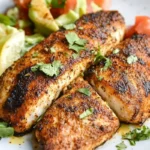
How to Make the Perfect Blackened Grouper: A Step-by-Step Guide with Pro Tips
- Total Time: 15 minutes
- Yield: 2 servings
- Diet: Gluten Free
Ingredients
For the Blackening Seasoning:
- 2 tbsp paprika (regular or smoked for extra depth)
- 1 tsp cayenne pepper (adjust for spice level)
- 1 tsp black pepper
- Garlic powder (1 tsp)
- 1 tsp onion powder
- 1 tsp dried oregano
- Dried thyme (1 tsp)
- 1 tsp salt
For the Grouper:
- 2 fresh grouper fillets (6-8 oz each)
- 2 tbsp unsalted butter (melted)
- 1 tbsp high-heat oil (avocado or vegetable oil)
- Lemon wedges (for serving)
- Fresh cilantro or parsley (for garnish)
Instructions
1: Prepare the Grouper
Pat the fillets dry with a paper towel to remove excess moisture—this helps the seasoning stick and ensures a crispier crust.
Brush each fillet with melted butter on both sides. This adds richness and helps the blackening seasoning adhere.
Generously coat the fish with the blackening seasoning mix, pressing it onto the fillets for even coverage.
2: Preheat the Skillet
Heat a cast-iron skillet over medium-high heat for 5 minutes until it’s smoking hot. This high heat is key for achieving that signature blackened crust.
Add 1 tbsp of oil and 1 tbsp of butter to the pan—this creates the sizzling base for a perfect sear.
3: Cook the Blackened Grouper
Carefully place the fillets in the skillet and cook undisturbed for 2-3 minutes. The seasoning will start to form a dark, flavorful crust.
Flip the fillets gently using a fish spatula and cook for another 2-3 minutes on the other side. The fish should be opaque, flaky, and golden brown.
If your fillets are extra thick, lower the heat slightly and cook for an additional 1-2 minutes to ensure the center is fully done.
4: Serve and Garnish
Transfer the fillets to a plate and let them rest for 2 minutes before serving.
Squeeze fresh lemon juice over the fish for brightness and balance.
Garnish with chopped cilantro or parsley for a pop of freshness.
Serve with your favorite sides like coleslaw, grilled vegetables, or Cajun rice for a complete meal!
- Prep Time: 5 minutes
- Cook Time: 6-8 minutes
- Category: Dinner
- Method: Pan-searing (Blackening)
- Cuisine: Cajun / Creole

